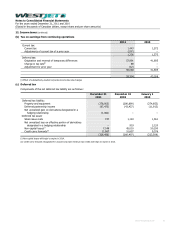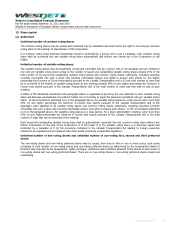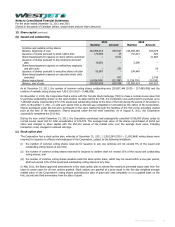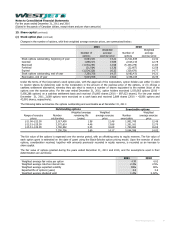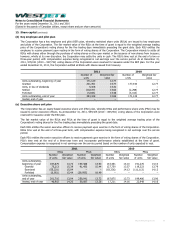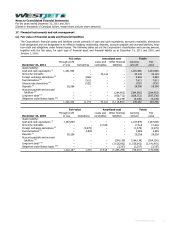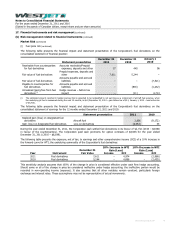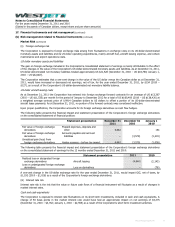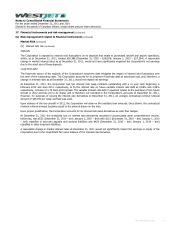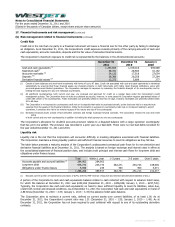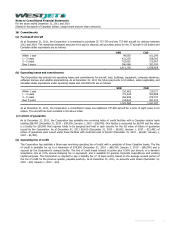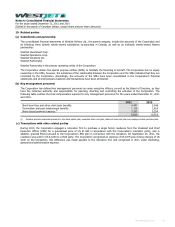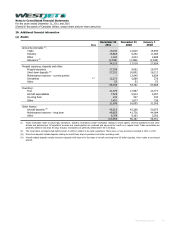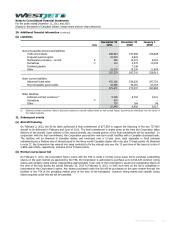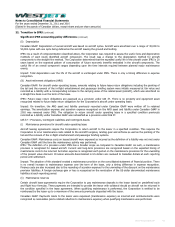Westjet 2011 Annual Report Download - page 94
Download and view the complete annual report
Please find page 94 of the 2011 Westjet annual report below. You can navigate through the pages in the report by either clicking on the pages listed below, or by using the keyword search tool below to find specific information within the annual report.
Notes to Consolidated Financial Statements
For the years ended December 31, 2011 and 2010
(Stated in thousands of Canadian dollars, except share and per share amounts)
│
17. Financial instruments and risk management (continued)
(a) Fair value of financial assets and financial liabilities (continued)
Deposits: Relate to purchased aircraft and airport operations and are based on a floating market rate of interest. Classified in
level 1 as the measurement inputs are unadjusted, observable inputs in an active market.
Long-term debt: The fair value of the Corporation’s fixed-rate long-term debt is determined by discounting the future
contractual cash flows under the current financing arrangements at discount rates presently available to the Corporation for
loans with similar terms and remaining maturities. At December 31, 2011, the rates used in determining the fair value ranged
from 1.28% to 1.61% (December 31, 2010 – 2.00% to 2.74%; January 1, 2010 – 2.28% to 3.27%).
(b) Risk management related to financial instruments
The Corporation is exposed to market, credit and liquidity risks associated with its financial assets and liabilities. From time to
time, the Corporation will use various financial derivatives to reduce exposures from changes in foreign exchange rates, interest
rates and jet fuel prices. The Corporation does not hold or use any derivative instruments for trading or speculative purposes.
The Corporation’s Board of Directors has responsibility for the establishment and approval of the Corporation’s overall risk
management policies, including those related to financial instruments. Management performs continuous assessments so that all
significant risks related to financial instruments are reviewed and addressed in light of changes to market conditions and the
Corporation’s operating activities.
Market Risk
Market risk is the risk that the fair value or future cash flows of a financial instrument will fluctuate due to changes in market
prices. The Corporation’s significant market risks relate to fuel price risk, foreign exchange risk and interest rate risk.
(i) Fuel price risk
The airline industry is inherently dependent upon jet fuel to operate and, therefore, the Corporation is exposed to the risk of
volatile fuel prices. Fuel prices are impacted by a host of factors outside the Corporation’s control, such as significant weather
events, geopolitical tensions, refinery capacity, and global demand and supply. For the year ended December 31, 2011, aircraft
fuel expense represented approximately 33% (2010 – 28%) of the Corporation’s total operating expenses.
Under the Corporation’s fuel price risk management policy, the Corporation is permitted to hedge a portion of its future
anticipated jet fuel purchases for up to 36 months, as approved by the Board of Directors. The hedging program is designed to
mitigate the risk of sudden and substantial movements in fuel prices causing volatility in earnings and cash flows. Management
continuously reviews its hedging positions based on market conditions and competitors’ positions. Financial derivatives in crude-
oil-based commodities (including a variety of crude oil, heating oil and jet fuel benchmarks) that are traded directly on organized
exchanges or are available over the counter are used by the Corporation to mitigate the risk of volatile fuel prices.
As at December 31, 2011, the Corporation had Canadian-dollar West Texas Intermediate (WTI) call options to hedge
approximately 23% of its anticipated jet fuel requirements for the next 12 months. The following table outlines, per year, as at
December 31, 2011, the notional volumes per barrel (bbl.) along with the weighted average contract prices:
Type Period Instrument Notional volumes (bbl.) WTI average strike price
($ CAD/bbl.)
WTI Q1 2012 Call options 420,000 117
WTI Q2 2012 Call options 430,000 112
WTI Q3 2012 Call options 520,000 109
WTI Q4 2012 Call options 240,000 115
Upon proper qualification, the Corporation accounts for its fuel derivatives as cash flow hedges.
WestJet Annual Report 2011 94


